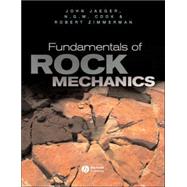
Neville G. W. Cook received a BS and PhD in geophysics from the University of Witwatersrand. He was the founder and first director of the Mining Research Laboratory of the South African Chamber of Mines, and in 1971 he received the Gold Medal of the Scientific and Technical Societies, the highest scientific award in South Africa. He was Donald H. McLaughlin Chair in Mineral Engineering at the University of California at Berkeley, and was a member of the U. S. National Academy of Engineering.
Robert Zimmerman received BS and MS degrees from Columbia University, and a PhD from the University of California at Berkeley. He has been a staff scientist in the Earth Sciences Division of the Lawrence Berkeley National Laboratory, and Reader in Rock Mechanics at Imperial College, London. He is currently Professor of Engineering Geology at the Royal Institute of Technology in Stockholm, and co-editor of the International Journal of Rock Mechanics. He is also the author of the monograph Compressibility of Sandstones.
| Rock as a Material | |
| Introduction | |
| Joints and faults | |
| Rock-forming minerals | |
| The fabric of rocks | |
| The mechanical nature of rock | |
| Analysis of Stress and Strain | |
| Introduction | |
| Definition of traction and stress | |
| Analysis of stress in two dimensions | |
| Graphical representations of stress in two dimensions | |
| Stresses in three dimensions | |
| Stress transformations in three dimensions | |
| Mohr's representation of stress in three dimensions | |
| Stress invariants and stress deviation | |
| Displacement and strain | |
| Infinitesimal strain in two dimensions | |
| Infinitesimal strain in three dimensions | |
| Determination of principle stresses or strains from measurements | |
| Compatibility equations | |
| Stress and strain in polar and cylindrical coordinates | |
| Finite strain | |
| Friction on Rock Surfaces | |
| Introduction | |
| Amonton's law | |
| Friction on rock surfaces | |
| Stick-slip oscillations | |
| Sliding on a plane of weakness | |
| Effects of time and velocity | |
| Deformation and Failure of Rock | |
| Introduction | |
| The stress-strain curve | |
| Effects of confining stress and temperature | |
| Types of fracture | |
| Coulomb failure criterion | |
| Mohr's hypothesis | |
| Effects of pore fluids | |
| Failure under true-triaxial conditions | |
| The effect of anisotropy on strength | |
| Linear Elasticity | |
| Introduction | |
| Stress-strain relations for an isotropic linear elastic solid | |
| Special cases | |
| Hooke's law in terms of deviatoric stresses and strains | |
| Equations of stress equilibrium | |
| Equations of stress equilibrium in cylindrical and spherical coordinates | |
| Airy stress functions | |
| Elastic strain energy and related principles | |
| Uniqueness theorem for elasticity problems | |
| Stress-strain relations for anisotropic materials | |
| Laboratory Testing of Rocks | |
| Introduction | |
| Hydrostatic tests | |
| Uniaxial compression | |
| Triaxial tests | |
| Stability and stiff testing machines | |
| True-triaxial tests | |
| Diametral compression of cylinders | |
| Torsion of circular cylinders | |
| Bending tests | |
| Hollow cylinders | |
| Poroelasticity and Thermoelasticity | |
| Introduction | |
| Hydrostatic poroelasticity | |
| Undrained compression | |
| Constitutive equations of poroelasticity | |
| Equations of stress equilibrium and fluid flow | |
| One-dimensional consolidation | |
| Applications of poroelasticity | |
| Thermoelasticity | |
| Stresses around Cavities and Excavations | |
| Introduction | |
| Complex variable method for two-dimensional elasticity problems | |
| Homogeneous state of stress | |
| Pressurised hollow cylinder | |
| Circular hole in a rock mass with given far-field principal stresses | |
| Stresses applied to a circular hole in an infinite rock mass | |
| Stresses applied to the surface of a solid cylinder | |
| Inclusions in an infinite region | |
| Elliptical hole in an infinite rock mass | |
| Stresses near a crack tip | |
| Nearly rectangular hole | |
| Spherical cavities | |
| Penny-shaped cracks | |
| Interactions between nearby cavities | |
| Inelastic Behavior | |
| Introduction | |
| Plasticity and yield | |
| Elastic-plastic hollow cylinder | |
| Circular hole in an elastic-brittle-plastic rock mass | |
| Perfectly plastic behavior | |
| Flow between flat surfaces | |
| Flow rules and hardening | |
| Creep | |
| Simple rheological models | |
| Theory of viscoelasticity | |
| Some simple viscoelastic problems | |
| Micromechanical Models | |
| Introduction | |
| Effective moduli of heterogeneous rocks | |
| Effect of pores on compressibility | |
| Crack closure and elastic nonlinearity | |
| Effective medium theories | |
| Sliding crack friction and hysteres | |
| Table of Contents provided by Publisher. All Rights Reserved. |
The New copy of this book will include any supplemental materials advertised. Please check the title of the book to determine if it should include any access cards, study guides, lab manuals, CDs, etc.
The Used, Rental and eBook copies of this book are not guaranteed to include any supplemental materials. Typically, only the book itself is included. This is true even if the title states it includes any access cards, study guides, lab manuals, CDs, etc.